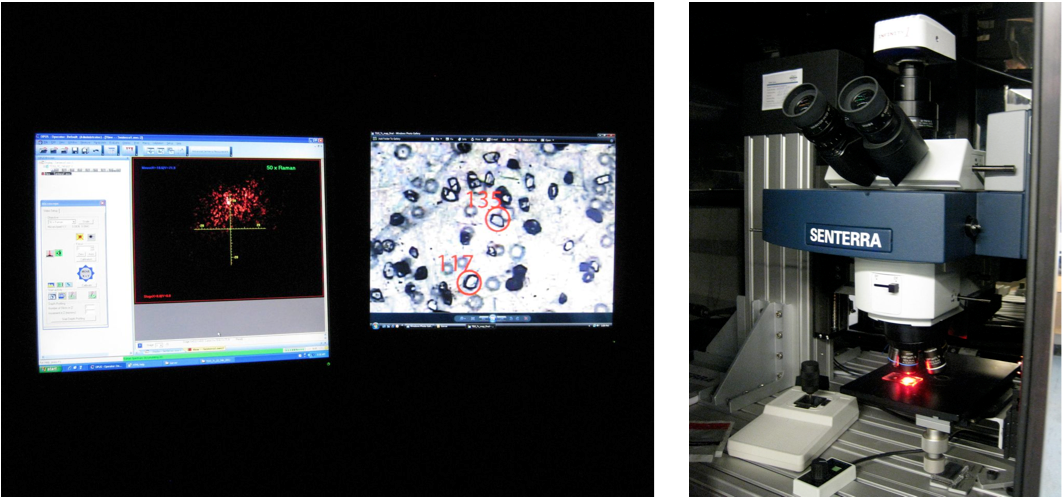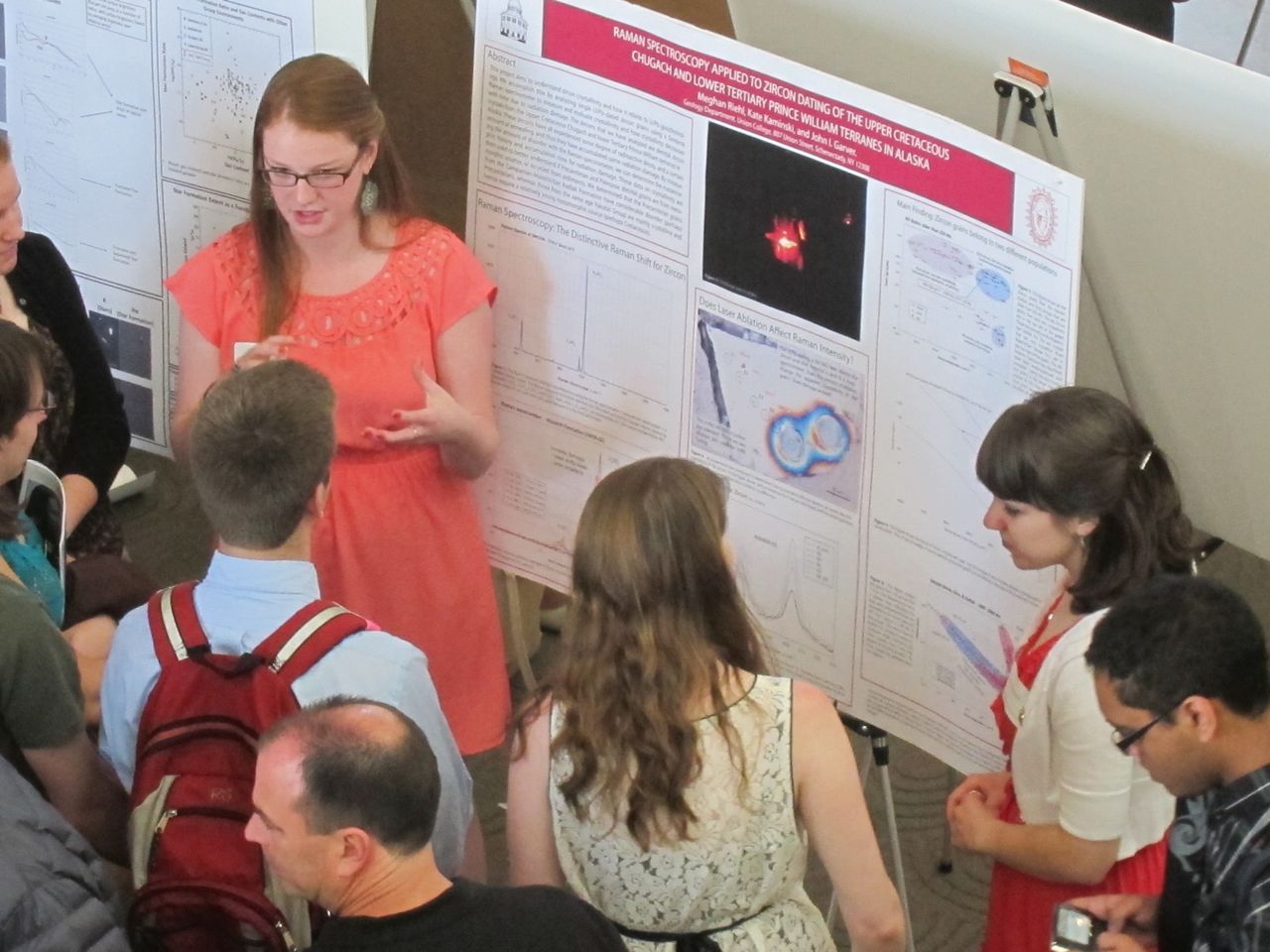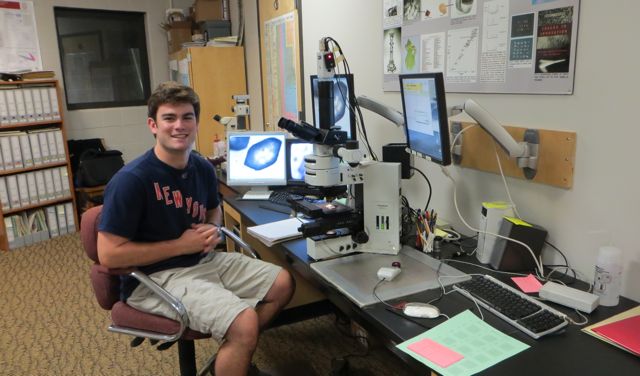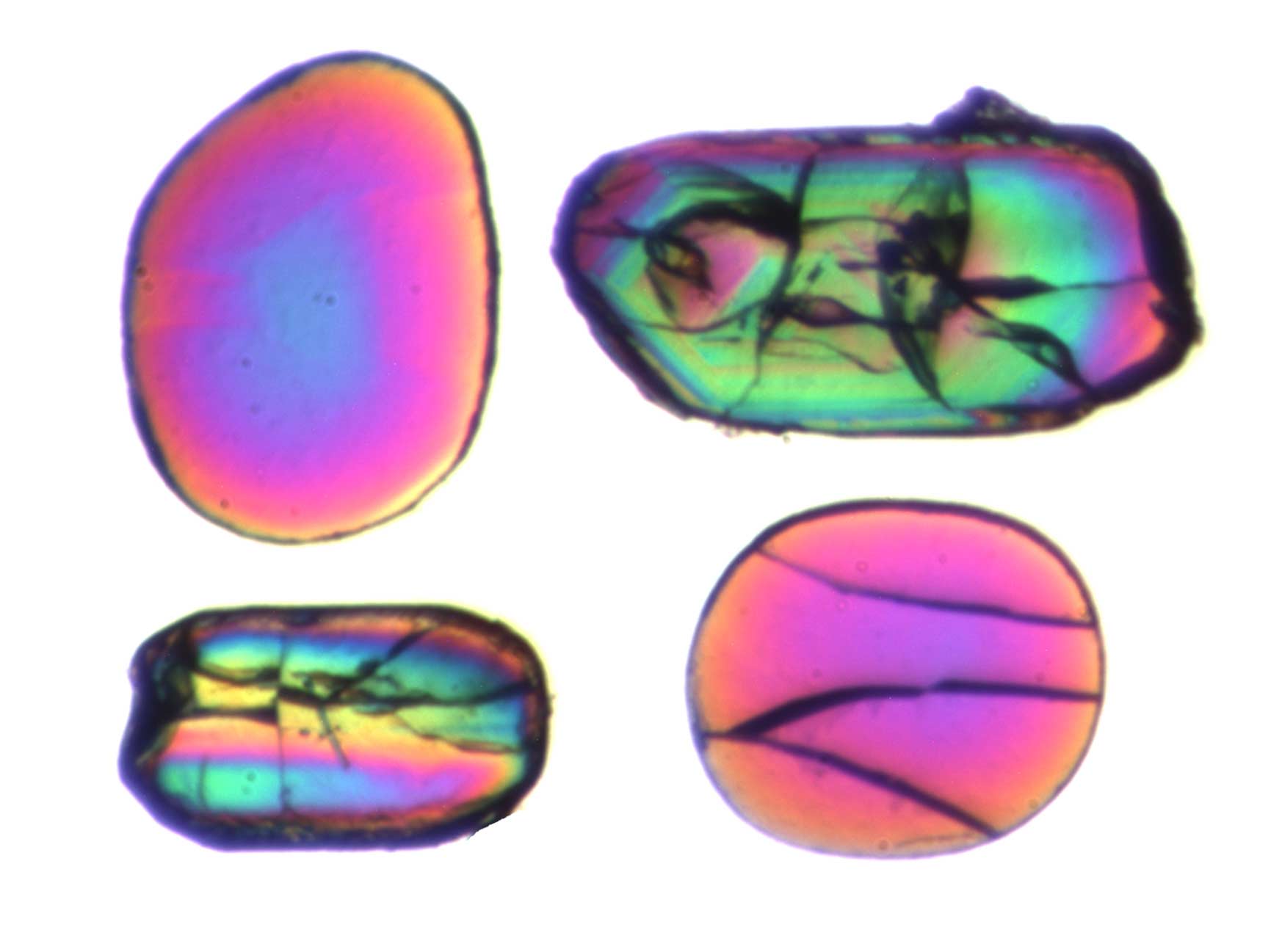Union College Fission track Lab
The Union College fission track lab is primarily focussed on fission track dating of zircon and understanding radiation damage. We do traditional fission track studies to understand orogenic development, thermal studies related to fluids and ore forming events, and low-temperature studies in the analysis of basin maturation. A significant fraction of our work involves understanding radiation damage in zircon, and much of this work is done with Raman Spectroscopy.
1) Research results and PDFs from the Union College FT lab (see list below)
2) Fission-track theses completed at Union College. (here)
3) Data analysis helps demystify how we use data files. (here)
4) Handbook of laboratory procedures used at Union. (here)
5) Facilities and equipment at Union. (here)
6) Summary of methodologies used to etch zircon in labs around the world. (PDF)
7) Collecting detrital samples in the field. (here)
8) Data analysis helps demystify how we use data files. (here)
9) The Detrital page directs you to detrital work, and lab procedures. (here)
10) Our RATES for zircon fission track analysis
Keck Alaska - Evolution of the Chugach-Prince William flysch
This multi-year research effort is focused on the provenance and thermal evolution of Campanian-Paleocene flysch of the Chugach-Prince William (CPW) terrane in southern Alaska. This thick and extensive accretionary complex was intruded by near-trench plutons inferred to be related to an adjacent trench-ridge-trench triple junction, but the location of this terrane at the time of ridge interaction is under debate. This multidisciplinary work has focused on determination of U/Pb and ZFT ages of detrital zircon to unravel the source region of this accretionary complex and subsequent thermal history. To target unique and age-distinctive rocks in potential source pathways, a small but highly significant population of Precambrian grains will be selectively targeted for provenance analysis. Using a newly developed technique of ZFT dating low-retentive zircon, radiation-damaged grains will reveal the low-temperature thermal history of the CPW following low-grade metamorphism (lower greenschist and prehnite-pumpellyite). Together, these data yield important constraints on the accretion and translation history of the CPW and has implications for the history of flanking basins such as the hydrocarbon-rich Cook Inlet basin.. Details of the our multi-year effort in southern Alaska is at this web page.

Sampling sandstones of the Upper Cretaceous Shumagin Formation, Nagai Island, Alaska
Raman Spectroscopy
A major avenue of our research involves using μ-Raman to measure and evaluate reduction of zircon crystallinity due to accumulated radiation defects. Much of this work has been directly related to student and faculty research. The focus here is on detrital zircon that has been dated by fission-track and by uranium-lead methods, and therefore we know actinide concentrations in individual crystals. Shift in the Raman wavenumber of the ν3(SiO4) peak is directly related to actinide content and degree of radiation damage. This research is partly related to the identification of Precambrian source rocks that supplied sediment to basins in the North American Cordillera.

We use a Bruker Senterra μ-Raman spectrometer housed in the Olin Building at Union College. Picture on the right shows a sample during analysis (door open) with the 633 nm He-Ne laser. The map of where that grain occurs in the Teflon® mount is to the right of the controlling computer screen. Using this approach we are able to routinely analyze single zircon grains to gain a better understanding of geochronometric analyses.

Student explain results of analyses of Precambrian zircons from the Chugach-Prince William terrane in Alaska (22th Annual Steinmetz Symposium, Union College, May 2012
Key FT publications (Alaskan tectonics below)
Wang, A., Garver, J.I., Wang, G., Smith, J.A., Zhang, K, 2010, Episodic exhumation of the Greater Himalayan Sequence since the Miocene constrained by fission track thermochronology in Nyalam, central Himalaya, Tectonophysics, p. 315-320. (PDF)
Batt, G.E., Cashman, S.M., Garver, J.I., and Bigelow, J.J., 2010. Thermotectonic evidence for two-stage extension on the Trinity detachment surface, Eastern Klamath mountains, California; American Journal of Science, v. 310, p. 261-281. (PDF)
Enkelmann, E., Zeitler, P.K., Garver, J.I., Pavlis, T.P. and Hooks, B.P, 2010. The thermochronological record of tectonic and surface process interaction at the Yakutat–North American collision zone in southeast Alaska; American Journal of Science, v. 310, p. 231-260. (PDF)
Marsellos, A.E., Garver, J.I., 2010, Radiation damage and uranium concentration in zircon as assessed by Raman spectroscopy and neutron irradiation; American Mineralogist, Volume 95, pages 1192–1201.(PDF)
Marsellos, A.E., Kidd, W.S.F., and Garver, J.I., 2010. Extension and exhumation of the HP/LT rocks in the Hellenic foreare ridge; American Journal of Science, v. 310, p. 1–36. (PDF)
Bernet, M., Brandon, M., Garver, J., Balestieri, M.L., Ventura, B., and Zattin, M, 2009, Exhuming the Alps through time: clues from detrital zircon fission-track thermochronology. Basin Research, v. 21, Issue 6, p. 781–798. (PDF)
Montario, M.J., and Garver, J.I., 2009, The thermal evolution of the Grenville Terrane revealed through U-Pb and Fission-Track analysis of detrital Zircon from Cambro-Ordovician quartz arenites of the Potsdam and Galway Formations; Journal of Geology, vol. 117, no. 6, p. 595-614. (PDF)
Draper, S., Evans, J., Garver, J.I., and Kirschner, D. and Janecke, S.U. 2009, Arkosic rocks from the San Andreas Fault observatory at Depth (SAFOD) borehole, central California: implications for tectonics along the San Andreas Fault. Lithosphere 1; p. 206-226.(PDF)
Gombosi, D.J., Barbeau, D.L., Garver J.I., 2009. New thermochonometric constraints on the rapid Paleogene exhumation of the Cordillera Darwin complex related thrust sheets in the Fuegian Andes. Terra Nova, v. 21, n. 6, p. 507–515. (PDF)
Enkelmann, E., Zeitler, P.K., Pavlis, T.L., Garver, J.I., Ridgway, K.D. 2009. Intense Localized Rock Uplift and Erosion in the St. Elias Orogen of Alaska. Nature Geoscience 2, no. 5, p. 360-363. (PDF)
Meigs, A., Johnston, S., Garver, J.I., and Spotila, J., 2008, Crustal-scale structural architecture, shortening, and exhumation of an active, eroding orogenic wedge (Chugach/St Elias Range, southern Alaska), Tectonics, v. 27, TC4003, 26 pp. (PDF)
Garver, J.I., 2008, Fission-track dating. In Encyclopedia of Paleoclimatology and Ancient Environments, V. Gornitz, (Ed.), Encyclopedia of Earth Science Series, Kluwer Academic Press, p. 247-249. (PDF)
Enkelmann, E., Garver, J.I., and Pavlis, T.L., 2008, Rapid exhumation of ice-covered rocks of the Chugach-St. Elias Orogen, Southeast Alaska. Geology, v. 36, n.12, p. 915-918. (PDF)
Perry, S.E., Garver, J.I., and Ridgeway, K., 2009, Transport of the Yakutat Terrane, southern Alaska, evidence from sediment petrology and detrital zircon fission-track and U/Pb double dating. Journal of Geology. V. 117, n. 3. p. 156-173. (PDF)
Fellin, M.G., Vance, J.A., Zattin, M., Garver, J.I., 2006. The Thermal evolution of Corsica as recorded by zircon fission tracks, Tectonophysics, 421, 299-317. (PDF)
Bernet, M., and Garver, J.I., 2005, Chapter 8: Fission-track analysis of Detrital zircon, In P.W. Reiners, and T. A. Ehlers, (eds.), Low-Temperature thermochronology: Techniques, Interpretations, and Applications, Reviews in Mineralogy and Geochemistry Series, v. 58, p. 205-237. (PDF)
Garver, J.I., Reiners, P.R., Walker, L.J., Ramage, J.M., Perry, S.E., 2005, Implications for timing of Andean uplift based on thermal resetting of radiation-damaged zircon in the Cordillera Huayhuash, northern Perú, Journal of Geology, v. 113, n. 2, p. 117-138. (PDF)
Rahn, M.K., Brandon, M.T., Batt, G.E., and Garver, J.I., 2004, A zero-damage model for fission-track annealing in zircon. American Mineralogist, v. 89, n. 3. p.473-484. (PDF)
Garver, J.I., 2002, Etching age standards for fission track analysis; Radiation Measurements, v. 37, n. 1, p. 47-54.(PDF)
Garver, J.I., 2002, Discussion: "Metamictization of natural zircon: accumulation versus thermal annealing of radioactivity-induced damage." Contributions to Mineralogy and Petrology, v. 143, p. 756-757. (PDF)
Garver, J.I., and Kamp, P.J.J., 2002, Integration of zircon color and zircon fission track zonation patterns in Orogenic belts: Application of the Southern Alps, New Zealand; Tectonophysics. v. 349, n. 1-4, p. 203-219. (PDF)
Garver, J.I., Soloviev, A.V., Bullen, M.E., and Brandon, M.T., 2000, Towards a more complete record of magmatism and exhumation in continental arcs using detrital fission track thermochronometry; Physics and Chemistry of the Earth, v. 25, n. 6-7, p. 565-570. (PDF)
Garver, J.I., Brandon, M.T., Roden-Tice, M., and Kamp, P.J.J., 1999, Erosional denudation determined by fission-track ages of detrital apatite and zircon, in Ring, U., Brandon, M.T., Willett, S., and Lister, G. (editors), Exhumation Processes: Normal Faulting, Ductile Flow, and Erosion, Geological Society of London Special Publication 154, p. 283-304. (PDF)
Brandon, M.T., Roden-Tice, M.R., and Garver, J.I., 1998, Late Cenozoic exhumation of the Cascadia accretionary wedge in the Olympic Mountains, northwest Washington State, Geological Society of America Bulletin, v 100, p. 985-1009. (PDF)
Alaskan Tectonics and Keck
Enkelmann, E., Zeitler, P.K., Garver, J.I., Pavlis, T.P. and Hooks, B.P, 2010. The thermochronological record of tectonic and surface process interaction at the Yakutat–North American collision zone in southeast Alaska; American Journal of Science, v. 310, p. 231-260. (PDF)
Enkelmann, E., Garver, J.I., and Pavlis, T.L., 2008, Rapid exhumation of ice-covered rocks of the Chugach-St. Elias Orogen, Southeast Alaska. Geology, v. 36, n.12, p. 915-918. (PDF)
Enkelmann, E., Zeitler, P.K., Pavlis, T.L., Garver, J.I., Ridgway, K.D. 2009. Intense Localized Rock Uplift and Erosion in the St. Elias Orogen of Alaska. Nature Geoscience 2, no. 5, p. 360-363. (PDF)
Meigs, A., Johnston, S., Garver, J.I., and Spotila, J., 2008, Crustal-scale structural architecture, shortening, and exhumation of an active, eroding orogenic wedge (Chugach/St Elias Range, southern Alaska), Tectonics, v. 27, TC4003, 26 pp. (PDF)
Perry, S.E., Garver, J.I., and Ridgeway, K., 2009, Transport of the Yakutat Terrane, southern Alaska, evidence from sediment petrology and detrital zircon fission-track and U/Pb double dating. Journal of Geology. V. 117, n. 3. p. 156-173. (PDF)
Garver, J.I., and Davidson, C., 2012, Tectonic evolution of the Chugach-Prince William terrane in Prince William Sound and Kodiak Island, Alaska, Proceedings from the 25th Keck Geology Consortium Undergraduate Research Symposium, Amherst, p.1-7 (PDF)
Carlson, B.M, 2012, Cooling and provenance revealed through detrital zircon fission track dating of the Upper Cretaceous Valdez Group and Paleogene Orca Group in Western Prince William Sound, Alaska, Proceedings from the 25th Keck Geology Consortium Undergraduate Research Symposium, Amherst MA, p. 8-16 (PDF)
Espinosa, S., 2012, Paleomagnetism of the Knight Island Ophiolite, Southern Alaska; Proceedings from the 25th Keck Geology Consortium Undergraduate Research Symposium, Amherst MA, p. 17-22 (PDF)
Hilbert-Wolf, H.L., 2012, U/Pb detrital zircon provenance of the flysch of the Paleogene Orca Group, Chugach-Prince William terrane, Alaska; Proceedings from the 25th Keck Geology Consortium Undergraduate Research Symposium, Amherst MA, 23-32 (PDF)
Johnson, E, 2012, Origin of Late Eocene granitiods in western Prince William Sound, Alaska; Proceedings from the 25th Keck Geology Consortium Undergraduate Research Symposium, Amherst MA, p. 33-39 (PDF)
Miner, L., 2012, Geochemical analysis of Eocene Orca Group volcanics, Paleocene Knight Island Ophiolite, and Chenega Island volcanics in Prince William Sound, Alaska; Proceedings from the 25th Keck Geology Consortium Undergraduate Research Symposium, Amherst MA, p. 40-49 (PDF)
Olivas, S., 2012, U/Pb detrital zircon study of the Upper Cretaceous to Miocene strata of Kodiak Island, Alaska; Proceedings from the 25th Keck Geology Consortium Undergraduate Research Symposium, Amherst MA, p. 48-53 (PDF)

Mike DeLuca counts fission tracks in detrital zircon from the Shumagin Islands (Alaska) as part of our effort to understand the tectonothermal evolution of the Chugach terrane
